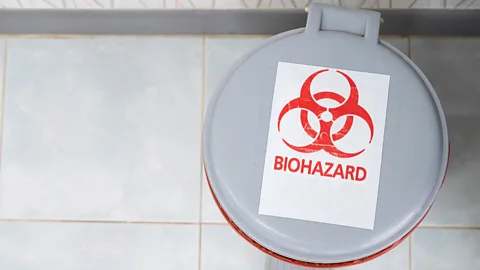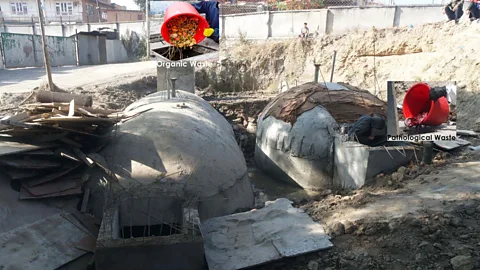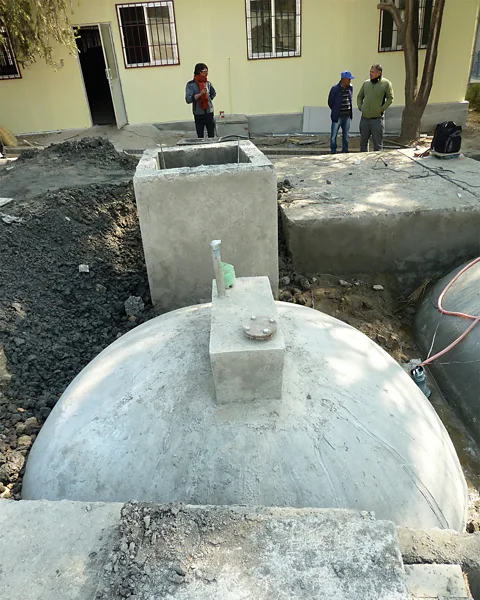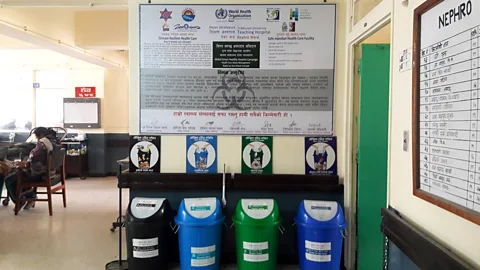Nepal's inventive use for waste placentas
 Getty Images
Getty ImagesThe burning of medical waste poses a serious health and environmental danger. Hospitals in Nepal have started turning this hazardous waste into cooking gas.
Hospital staff close to the incinerator complained of persistent coughs, breathing difficulties, headaches, sore eyes and rashes. The black, noxious smoke that poured out of its chimney wafted in through the windows of Tribhuvan University Teaching Hospital (TUTH) in Nepal's capital Kathmandu. Staff reluctantly closed them to protect their vulnerable patients: children and babies in paediatric and neonatal intensive care, and adults with respiratory illnesses.
"Keeping the windows shut caused the rooms to overheat and added to the discomfort," recalls Deepak Mahara, former TUTH executive director who has now retired. "When the incinerator was operational, smoke frequently drifted into these sensitive areas, causing significant distress. The foul smell made the work environment uncomfortable."
Despite this, no one realised their symptoms were connected to the incinerator's emissions until 2014, when a local non-profit, the Health Environment and Climate Action Foundation (HECAF360), approached hospital managers to suggest replacing the offensive furnace with an underground biodigester. Staff not only faced long-term health conditions if they continued to be exposed to the poisoned air, but the hospital was also causing broader public health and environmental dangers, HECAF360 warned. Low-quality incineration of health care waste releases dioxins and furans into the atmosphere – chemicals both classified as human carcinogens. While medical waste that is dumped outside of hospital grounds poses risks to anyone who may come into contact with it, such as waste pickers on dump sites.
"We were unaware of the negative impact of the mismanagement of healthcare waste," says Mahara. Realising the issue was serious, he agreed to take action. "It needed to be addressed immediately to comply with hospital's mission to 'do no harm'," he says.
 Alamy
AlamyThe situation at TUTH is common. Hospitals worldwide use incinerators to eradicate rubbish. It is the method most commonly used in developing countries to dispose of infectious waste, according to a UN Human Rights Council report. The report highlights that if medical facilities have small-scale incinerators, or manage them incorrectly, this can lead to dioxins emissions that are 40,000 times higher than emission limits set forth in the Stockholm Convention on Persistent Organic Pollutants.
In Nepal, hospitals and healthcare centres generate between 1 and 1.7kg (2.2 and 3.7lb) of healthcare waste per bed each day, according to Health Care Without Harm (HCWH), a global non-profit working to reduce healthcare services' negative impacts on the environment and people. One study estimates low-income countries produce up to 6kg (13.3lb) of hazardous waste per bed per day, which rises to 11kg (24.3lb) in high-income nations.
The safe approach to medical waste management is to separate and treat wastes differently. According to the World Health Organization (WHO), 15% of healthcare waste is hazardous material that may be infectious, toxic or radioactive. Waste must all be segregated before disposal, but just one-third of healthcare facilities do this. This has a detrimental impact on people and the planet. About 5.2 million people, including four million children, die each year from waste-related diseases around the world.
Pathological waste, such as human tissue, organs or amputated body parts, also carry risk because they may contain pathogens: disease-causing viruses and bacteria. Non-burn technologies are available to treat potentially bio-hazardous waste, such as autoclaving and microwave treatment before disposal. But in 2014, when the project at TUTH began, most Nepali hospitals were disposing of healthcare waste by burying it on-site, open burning or incinerating with "little or no air pollution control", according to a 2019 report on the project by HCWH international science and policy coordinator Ruth Stringer.
 HECAF360
HECAF360Mahesh Nakarmi, executive director and founder of HECAF360 in Nepal, is on a mission to clean up Nepal's healthcare waste management. When the qualified civil engineer arrived at the 700-bed Tribhuvan hospital in 2014 – the largest hospital in Nepal – he had already tried and tested a solution to replace the incinerator. "Everybody thinks burning is the solution, but this causes a lot of environmental consequences," says Nakarmi. "When I started this work, I wanted to find different solutions for different types of waste."
As at other hospitals where he had worked, Nakarmi began with a full assessment of all the processes of waste handling at TUTH. By 2017, the hospital had signed a contract with HECAF360 to implement changes across the services. They included new waste segregation approaches, installing autoclaves to disinfect all infectious waste (except pathological) at high temperatures before recycling or disposal, and the construction of a specially designed biodigester to replace the incinerator.
One of reasons the incinerator was causing so many problems was because of the type of waste handlers that were feeding it. Every day, one would carry a bucket of placentas from the hospital's maternity ward and throw them into the fire. These temporary organs, grown in female bodies during pregnancy, are a typical form of pathological waste.
CARBON COUNT
The travel emissions it took to report this story were 0kg CO2. The digital emissions from this story are an estimated 1.2g to 3.6g CO2 per page view. Find out more about how we calculated this figure here.
Burning placentas is challenging because they are mainly composed of water. An incinerator needs to reach high temperatures to break down the tissue. WHO recommends hospitals use two-chamber incinerators to meet temperatures of 850C to 1100C (1562F and 2012F) to reduce organic matter. But the incinerator at Tribhuvan was a diesel-fuelled single chamber unit with no pollution control.
To fuel the fire, hospital staff added recyclable materials such as paper and plastic, which release carbon dioxide (CO2). When they added equipment made of PVC, such as blood bags, intravenous lines and oxygen masks – these released highly toxic dioxins into the environment. Dioxins build up in the food chain and can lead to damaged immune systems, reproductive and developmental problems, and even cancer.
As well as replacing the incinerator, Nakarmi cautioned the hospital's policy of sending food waste to municipal landfill. At the time, leftover food for patients and kitchen scraps amounted to 189kg (417lb) of waste a day. Dumping biodegradable waste in landfills not only attracts cockroaches and rodents, but also releases methane, a potent greenhouse gas about 80 times more powerful over a 20-year time span than CO2, and is the primary contributor to ground-level ozone, which causes one million premature deaths every year.
 Ruth Stringer/HCWH
Ruth Stringer/HCWHThe biodigester solution began as a means of managing food waste. In 2011 HECAF360 built a single-chamber, underground biodigester at Bir Hospital, Kathmandu. A culture of biogas has existed in Nepal for more than 40 years, according to a nationwide survey, which suggests 69% of the country's total energy demand is met by biomass energy. Homes and farms dispose of their animals' manure into small biodigesters on their land, which releases methane gas to fuel cooking.
At Bir hospital, methane released by digested food waste was piped into the staff tearoom. But Nakarmi faced a new challenge at Kathmandu Medical College and Teaching Hospital, where he installed a biodigester in 2016. "After Bir, hospitals we worked with had maternity services which produce placentas as well as food waste," he says. "We modified the biodigester to make it suitable for both types of waste."
Nakarmi – together with Stringer and Dutch engineer Marijn Zandee, an independent technical advisor on biotechnology – developed a new model to safely digest both food and pathological waste. It worked so well the team went on to install three more at Grande City Hospital, Paropakar Maternity and Women's Hospital, and the largest at TUTH.
Stringer explains how the concrete TUTH model, which measures 50 cubic metres, works. The key adaptation to safely dispose of the pathological waste was to add a second chamber.
Before hospital staff began adding waste, constructors put in cow dung to "seed" the chambers. This contains bacteria the mix needs to digest the hospital waste and generate methane. Hospital workers throw pathological and some food waste into the first underground chamber through an inlet above the ground. The majority of the hospital's food waste goes into the second inlet and chamber. "You feed placentas and some food to balance that carbon and nitrogen into the first chamber," says Stringer. "Food, which is much bulkier but doesn't need such a long residence time – because there's no potential for infection – is fed into the second."
The team trained hospital staff to segregate waste and ensure they only fed suitable organic materials into the digester. Staff also regularly pour water into the inlets to keep the mixture fluid. Gravity slowly moves it though the system. The digestate ends its passage by tipping out of the second chamber into a sewer, from where it safely washes away. By this time, any pathogens have died. "Most viruses can last maximum a week outside of the body," says Stringer. "There's no risk."
Zandee explains that the two chambers were necessary, as food and placentas are "raw materials" compared to cow dung, which has already been partly digested. "We wanted to make sure that the waste would be as safe as it could be," he says. "You achieve that by keeping the material longer in the biogas plant than normally. It's about 70 days versus 150-180 days."
The biodigester has to be big enough to hold all the waste created by a hospital, while also needing to fit the shape and size of the location available, says Zandee. At the time, if Tribhuvan was at full capacity, it would produce 217kg (478lb) of food waste and 11.5kg (25lb) of pathological waste a day, adding up to 83 tonnes (182,984lb) per year.
 Ruth Stringer/HCWH
Ruth Stringer/HCWHThe methane gas produced by the biodigester at TUTH is piped out of the chambers into the staff room. It fuels a stove used for cooking, and has replaced some of the liquefied petroleum gas (LPG) the hospital used to buy. The biodigester in Tribhuvan produces 1.5 cubic metres a day of methane gas – the equivalent of five standard-size LPG gas cylinders. One cylinder is enough for a family of five to cook two meals a day for a month and costs about £15 ($20), according to Nakarmi.
Mahara says it was a "great challenge" to convince the entire hospital workforce to change their practices. Just 36% of the total organic waste the team anticipated the biodigester would process was fed in, according to a 2019 assessment. This was because not all wards were incorporated into the system, and some kitchen staff wanted to sell food waste for animal feed to supplement their income.
Frontline waste handlers were also unofficially selling recyclable materials to recycling vendors, such as syringes, gloves and tubes. "They were dependent on this revenue," says Mahara. "But unaware of the occupational risks this caused." HECAF360 taught hospitals to recycle some forms of medical waste, but first autoclave them – heat at high temperatures – to disinfect them.
But, in general, staff quotes in the survey point to satisfaction and wider benefits to society as a result of the changes. In the assessment, Dharma Laxmi Shrestha, hospital waste management coordinator at the time, said the whole service's environment and cleanliness had improved and that patients and staff were implementing more hygiene practices at home too.
By replacing the incinerator, 4.6 tonnes of CO2 emissions were avoided in 2019, as well as all diesel fuel and methane gas emissions, the assessment estimates.
More like this:
• Methane: the tricky hunt for hidden emissions
Kalidas Neupane, managing director of Pioneer Architect and Consulting Engineers' in Kathmandu and an independent biogas expert, says the biodigester is a good way to manage hospital waste. He suggests it would be improved by increasing the size of the digester to allow it to handle greater volumes of waste and applying a process called "hygienisation" – heating the mixture to at least 70C (158F) for a minimum of one hour – to ensure pathogens were removed faster. "The system was designed to work in a mesophilic [moderate temperature] condition, where the retention time needed is very long – for some pathogens more than 90 days," he says. With improvement the solution could be expanded globally, he adds.
The TUTH biodigester cost 3.5 million Nepali Rupees to construct – almost £20,000 ($26,400). It was funded through a combination of hospital budget and Nepali government funding, as well as technical support from HECAF360. Stringer expects the structure to last about 20 years, or longer if it avoids cracking. The digester at Bir Hospiral survived Nepal's 2015 7.3 magnitude earthquake. But a crack could be repaired safely, adds Stringer. Staff could stop adding pathological waste and wait until any pathogens died off naturally. "It would be completely safe to open it," she says.
 HECAF360
HECAF360The dichotomy that the very services aimed at healing people are causing harm happens for a number of reasons, according to Stringer. While biodigesters have proved their worth in Nepal, lack of awareness, lack of expertise, funding and political will all prevent further expansion of their use in health settings globally, she says.
Worldwide, health budgets are under pressure, and generally targeted towards the front-end of provision rather than its leftovers, says Stringer. Nepal's culture of biodigestion rendered it fertile ground to develop the technology, she says.
Installing a biodigester is beneficial for environmental and human health. But it is difficult to make a financial argument for hospitals to invest in the technology, says Zandee. "It's important not to oversell the amount of methane gas you can collect," he cautions. "You're not going to suddenly make a huge dent in your hospital's energy bill."
Furthermore, "there is zero data" to backup healthcare biodigesters' efficacy, says Stringer. Waste workers tend not to be included in surveys, so it is impossible to say their health has improved as a result of abandoning incineration or that viral or bacterial transmission has reduced for hospital staff and patients.
HCWH has tried to expand the approach in other countries. In India this proved fruitless, as Indian law rules all placentas must be burned, says Stringer. HCWH representatives in Brazil and Mexico tried to discuss the approach with their healthcare sectors to no avail. However, the approach has been used successfully in some African countries.
Between 2016 and 2020, HCWH partnered with WHO and the UN Development Programme to introduce environmentally friendly healthcare practices in Ghana, Madagascar, Tanzania and Zambia. Independent biogas consultant Christopher Kellner designed five hospital biodigesters in Zambia and Tanzania.
His design differed slightly to those in Nepal as he connected the chambers to existing hospital wastewater pipes. "In Nepal the workers have to add water," says Kellner. "For me that's not user-friendly. If you can add a placenta into an existing waste water stream [such as flushing it down a toilet], it's a hands-free operation."
Kellner also had a different solution for wastewater released by the biodigester. Instead of flowing into sewage pipes, at St Pauls Mission Hospital in Kashikishi, Zambia, he built gravel filters and encouraged hospital staff to plant banana trees above. "The water is clean but still contains nutrients," he says. "The bananas there are overwhelming!"
A 2020 report on the biodigester Kellner designed concluded it was "a practical solution for disposing of pathological waste", but suggested more awareness needed to be raised about the value of the technology, as some hospital staff felt uncomfortable using gas generated from placentas for cooking.
HECAF360 continues to encourage biodigester take-up in Nepal. It has another project agreed in a Kathmandu hospital but currently this has stalled because of funding. "Funding is a very big issue as no one understands the importance of medical waste management," says Nakarmi.
Stringer hopes WHO's recently published Global Framework for improvements in healthcare facilities, including waste, will encourage more sustainable approaches in waste management. She applauds its practical approach and setting of operational targets for 2030. However, she warns progress will be slow if politicians or officials responsible for making decisions about medical waste "don't have access to experts or don't have the confidence to trust their advice".
Today TUTH hospital staff and administrators are happy with the impact the digester has on waste management and environmental sustainability, says Mahara. "Since the incinerator was removed, conditions in the hospital have improved significantly," he says. "The toxic smoke no longer affects patients or staff, leading to a noticeable reduction in respiratory issues. Complaints about foul odours and health-related problems have also subsided."
The ugly incinerator has gone, and the biodigester, while no more beautiful, is hidden underground. Above it staff have planted grass and flowerbeds, where they can relax during a break while drinking a cup of methane-gas boiled tea.
--
For essential climate news and hopeful developments to your inbox, sign up to the Future Earth newsletter, while The Essential List delivers a handpicked selection of features and insights twice a week.
